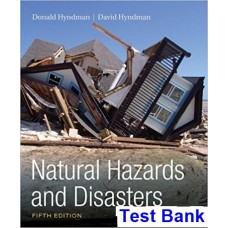Natural Hazards And Disasters 4th Edition by Donald Hyndman – Test Bank
Chapter 5
TSUNAMI
MULTIPLE-CHOICE QUESTIONS
- What are two main causes of tsunami?
- volcano flank collapse and sudden degassing of the mantle from a mid-oceanic ridge
- sudden changes in ocean-floor lithosphere velocity and major rockfall into the ocean
- asteroid impact into the ocean and collapse of a mid-oceanic ridge
- subduction-zone earthquakes and transform-fault earthquakes
- subduction-zone earthquakes and landslide into the ocean
ANSWER: e
- Which of the following submarine faults CANNOT cause tsunami waves?
- strike-slip faults
- normal faults
- subduction-zone faults
- thrust faults
- breakaway faults of major landslides
ANSWER: a
- As it enters a bay, the height of a tsunami wave:
- rises because more water from each wave is forced into less space.
- rises primarily because the bay narrows.
- rises because of thermal expansion in the warm water of the bay.
- drops because the wave must spread out and slow as it approaches the shore.
- drops because as the wave breaks it rushes ahead as a fast-moving swash.
ANSWER: a
- What is the average speed of tsunami waves in the deep ocean?
- 8-9 km/hour
- 80-90 km/hour
- 800-900 km/hour
- the speed of an Olympic sprinter
- the speed of light
ANSWER: c
5.Tsunami waves nearing the open coast:
- slow down because they don’t want to hit the coast too fast.
- speed up because they finally begin to feel bottom.
- slow down because they drag more on the shallower bottom than in the deep ocean.
- speed up because the shallower water forces the leading edge to squirt out ahead.
- speed up because the wave launches forward as it breaks.
ANSWER: c
- Although the Atlantic coast of North America experiences few large earthquakes, what specific other event could generate a large tsunami wave that could cause catastrophic damage there?
- a giant subduction-zone earthquake near the coast of Africa
- a giant subduction-zone earthquake along the eastern edge of North America
- a giant transform-fault earthquake on the Atlantic Ocean floor
- flank collapse of a volcano in the Canary Islands
- flank collapse of Mt. Vesuvius
ANSWER: d
- Why do ships in the open ocean NOT notice passage of a tsunami wave?
- The wave goes by so fast that it is gone before anyone notices.
- The long time between wave crests dictates that the wave flanks have almost no slope.
- Ships are carried on the crest of the wave, so they don’t feel any up or down motion.
- Although the wave crests are several hundred meters high, the time between them is several hours, so no one notices.
- The wave hits the ship so hard and fast that no one survives to tell about it.
ANSWER: b
- What type of event has repeatedly generated very high tsunami waves in coastal fjords of southeastern Alaska?
- a large rockfall into the fjord
- a giant subduction-zone earthquake
- a massive stratovolcano eruption
- an undersea landslide caused by liquefaction of beach sediments
- the toe of a fast-moving glacier suddenly surging forward
ANSWER: a
9.How are tsunami waves in the Atlantic Ocean likely to be generated?
- by sudden rise of the Mid-Atlantic Ridge
- by collapse of the flank of an oceanic island volcano
- by a huge iceberg suddenly grounding on the coast of Newfoundland
- a subduction-zone earthquake along the plate boundary just off eastern North America
- a large-magnitude earthquake on a transform fault on the ocean floor
ANSWER: b
- What is often the first indication of the arrival of a tsunami at the coast?
- a giant 100-meter-high wave looming on the horizon
- a sudden rise in sea level to a crest within about 20 seconds
- a rapid drop in sea level
- sea turtles running up the beach
- people running down to the beach to see the action
ANSWER: c
- What are the approximate wavelengths of tsunami waves?
- 36 meters
- 360 meters
- 3.6 kilometer
- 36 kilometers
- 360 kilometers
ANSWER: e
- What are the approximate times between tsunami wave crests?
- 30 seconds to 1 minute
- 1 to 3 minutes
- 10 to 35 minutes
- 2 to 3 hours
- 10 to 12 hours
ANSWER: c














Reviews
There are no reviews yet.